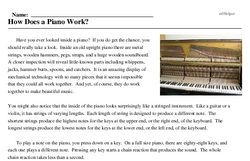How Does a Piano Work?
Have you ever looked inside a piano? If you do get the chance, you should really take a look. Inside an old upright piano there are metal strings, wooden hammers, pegs, straps, and a huge wooden soundboard. A closer inspection will reveal little-known parts including whippens, jacks, hammer butts, spoons, and catchers. It is an amazing display of mechanical technology with so many pieces that it seems impossible that they could all work together. And yet, of course, they do work together to make beautiful music.
You might also notice that the inside of the piano looks surprisingly like a stringed instrument. Like a guitar or a violin, it has strings of varying lengths. Each length of string is designed to produce a different note. The shortest strings produce the highest notes for the keys at the upper end, or the right end, of the keyboard. The longest strings produce the lowest notes for the keys at the lower end, or the left end, of the keyboard.
To play a note on the piano, you press down on a key. On a full size piano, there are eighty-eight keys, and each one plays a different note. Pressing any key starts a chain reaction that produces the sound. The whole chain reaction takes less than a second.
When you press down on a piano key, the back part of the key, which is hidden inside the piano, raises up in the same way that the opposite end of a see-saw raises up when you push down on one end. When the back end of the key raises up, it moves the parts called a sticker and a whippen, which are located on top of the key. The whippen pushes a jack, which pushes a hammer butt. The hammer butt turns and moves the hammer towards the strings.




